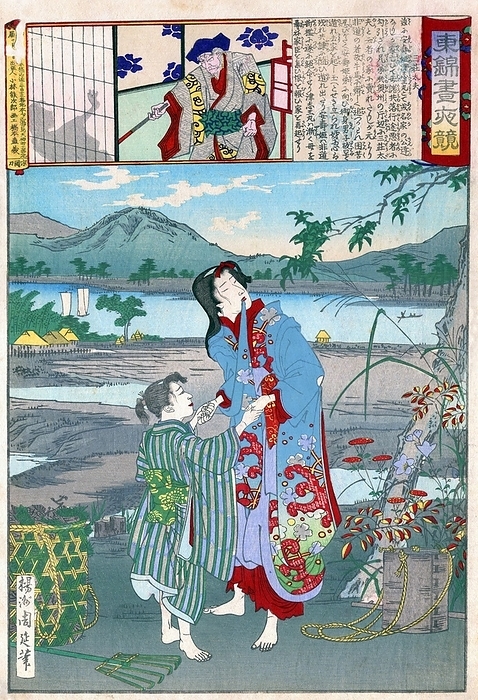
ED
Japan: Yasu-hime and Zushiomaru sold into slavery. Ukiyo-e woodblock print by (Toyohara) Yoshu Chikanobu (1838-1912)
Sansho Daiyu sold into slavery Yasu-hime and Zushiomaru, the daughter and son (shown here) of the provincial governor Iwaka Masauji, who had been overthrown and exiled. <br/><br/><br/>They were overthrown and exiled.
Iwaka's loyal retainer Tatebe Kanamenosuke attempted to rescue the children, but was himself captured and sentenced to death, to be beheaded at dawn. Sansho's daughter Osan turned into a fowl as the sun rose on the day of execution and chewed off the ropes of the prisoner.<br/><br/><br/> Iwaka's loyal retainer Tatebe Kanamenosuke attempted to rescue the children, but was himself captured and sentenced to death, to be beheaded at dawn.
Sansho then realises that Tatebe is his long lost son, and allows his son to kill him for all his evil deeds. Yura no Minato Sengen Choja, Tatebe and Osan commit suicide.<br/><br/><br/>Sansho then realises that Tatebe is his long lost son, and allows his son to kill him for all his evil deeds.
Toyohara Chikanobu (1838-1912), better known to his contemporaries as Yōshū Chikanobu, was a prolific woodblock artist of Japan's Meiji period. His works capture the transition from the age of the samurai to Meiji modernity.<br/><br/><br/>The work of Toyohara Chikanobu (1838-1912), better known to his contemporaries as Yōshū Chikanobu, was a prolific woodblock artist of Japan's Meiji period.
In 1875 (Meiji 8), he decided to try to make a living as an artist. He travelled to Tokyo. He found work as an artist for the Kaishin Shimbun. In his younger days, he had studied the Kanō school of painting; but his interest was drawn to ukiyo-e.<br/><br/>In 1875 (Meiji 8), he decided to try to make a living as an artist.
Like many ukiyo-e artists, Chikanobu turned his attention towards a great variety of subjects. As well as a number of the other artists of this period, he too portrayed kabuki actors in character, and is well-known for his impression. As well as a number of the other artists of this period, he too portrayed kabuki actors in character, and is well-known for his impressions of the mie (formal pose) of kabuki productions.<br/><br/><br/>These are the most important works of the period.
Chikanobu was known as a master of bijinga, images of beautiful women, and for illustrating changes in women's fashion, including both traditional and Western clothing. His work illustrated the changes in coiffures and make-up across time. hair styles of the Te
Details
ID
177779462
Collection
License type
Editorial
Photographer
Creation date
05-01-2022
Contact Aflo for all commercial uses.

More
Top Categories
